- Outras empresas da Fluke:
- Fluke
- Fluke Biomedical
- Fluke Networks
- Fluke Process Instruments
How to Accurately Calibrate a Hygrometer
What you will learn in this blog post:
- Why it's important to measure humidity
- What types of instruments measure humidity
- Why we need to calibrate humidity
- How to accurately calibrate a hygrometer or other humidity sensor, using a mixed-flow humidity calibrator
- Why and how to use a chilled-mirror probe or hygrometer as a reference
- Tips to ensure a successful humidity measurement
- Where to get more information about calibrating humidity or request help
- Definitions of common humidity terms
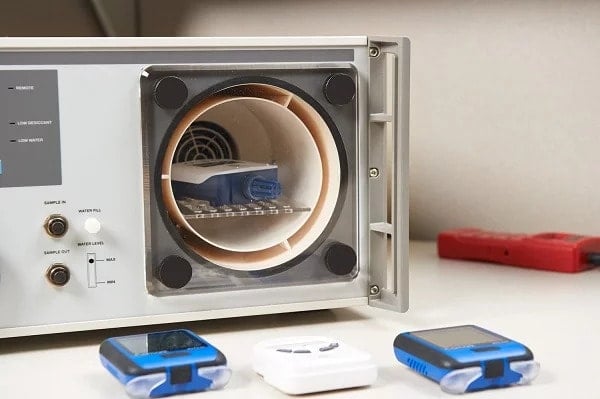 Calibrating Humidity Sensors with a Mixed-Flow Humidity Generator Calibrator
Calibrating Humidity Sensors with a Mixed-Flow Humidity Generator Calibrator
We want to assume that when we take medication, fly in an airplane, eat food, use chemical products or perform other normal tasks that the products and processes we use are safe and work effectively. But it’s a dangerous world out there and that is why industries like pharmaceuticals, semiconductors, chemicals, aerospace, food processing and the like have regulations in place to ensure the quality of their products and processes. These regulations typically require regular measurements of many parameters including temperature and humidity. Making sure that measurements are accurate is where calibration comes in.
Why is it important to measure humidity?
It is important to measure humidity because maintaining the correct temperature and humidity helps to keep products from spoiling. Products can spoil for a number of reasons, including:
- Condensation
- Bacteria and germ growth
- Mold
- Electrostatic discharge
- Corrosion
- Warping
To prevent these problems, industries with products at risk of spoilage install instruments to measure humidity and temperature continuously through the manufacturing process and also while products are stored.
What types of instruments measure humidity?
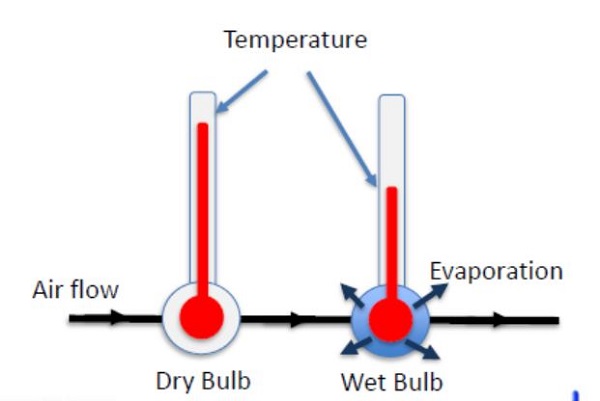
A psychrometer (wet/dry bulb) sensor measures humidity through the cooling effect of evaporation
Instruments that measure humidity include but are not limited to:
- RH (relative humidity) probes, meters and transmitters
- RH monitors and wall-mounted transmitters
- Humidity data loggers
- Digital thermometer hygrometer
- Psychrometers (wet/dry bulb)
- Metal-paper coil hygrometers
- Hair tension hygrometers
Why calibrate humidity?
It is important to calibrate humidity instruments regularly, to make sure they are performing within their manufacturers' specifications. Calibration lets you know that measurements made with these instruments are accurate so that quality can be maintained.
How to accurately calibrate a hygrometer or other humidity sensor
To most accurately calibrate a hygrometer or other humidity sensor, you need to generate and measure humidity at a variety of temperatures and humidity levels. To do this efficiently, you would use a humidity generator / calibrator. These measurements are compared with the measurements of the device under test (DUT). The difference between the two measurements lets you calculate the error of the DUT measurements.
The calibration process described here uses a mixed-flow humidity calibrator to generate and measure the humidity and temperature. This type of instrument has a chamber in which air is circulated through both a drier system and a humidifier system. A controller determines how much dry air and moist air to mix in the chamber. A calibrated chamber sensor determines the chamber humidity and temperature. This type of generator performs the calibration quickly and accurately.
Here are the steps for how to calibrate a hygrometer or other humidity sensor.
- Fill the humidity generator humidifier reservoir with distilled water according to the manufacturer’s directions.
- Remove any existing condensation from the chamber.
- Insert the device(s)-under-test (DUTs) into the chamber of the humidity generator. Depending on the type of sensor you are calibrating, you might be able to place it entirely inside the chamber or insert just the sensor portion through a port hole that keeps it in place.
- Set the chamber to the desired temperature and humidity set point.
- Set the lower relative humidity points first and ramp up to the higher levels on each subsequent calibration step.
- Set the lower temperature calibration points first to minimize the possibility of water vapor condensing inside the chamber.
- In general, best practice is to start at the temperature and humidity points that produce the lowest dew point and then move up. If necessary, points can be taken going down in temperature and/or humidity if the DUT requires this.
- Wait for the chamber and DUT to stabilize.
- Record the actual temperature and humidity displayed on the calibrator.
- Record the reading on the DUT(s).
- The difference between the calibrator’s readings and the DUT(s) readings tell you how much your DUT is “off.” If the difference it too great your sensor may need to be adjusted, repaired, or replaced.
Using a chilled-mirror probe or hygrometer as a reference during the calibration
If your humidity calibration workload requires a high level of accuracy, consider using an external reference to get the best measurement by comparing the reading on the DUT with the reference instead of with the calibrator’s display (we recommend 0.5 °C dew point uncertainty).
It’s common to use a chilled mirror hygrometer as the humidity reference and a reference grade digital thermometer as the temperature reference. A chilled mirror hygrometer is a humidity reference standard that measures dew point on a polished metal surface that is chilled until water begins to condense on it. At this point the dew point temperature is measured; an optical detection system measures the reflected light from the mirror’s surface.
The chilled mirror hygrometer also has an air temperature sensor that can be inserted in the humidity chamber next to the DUT. With dew point and air temperature measurements, relative humidity is calculated by the chilled mirror and measured to a high level of accuracy.
During the DUT calibration, the DUT’s reading is compared with the highly accurate relative humidity measured with the chilled mirror system. The DUT temperature sensor is compared either with the chilled mirror air temperature thermometer or with a reference grade digital thermometer system that is inserted in the chamber with the DUT.
Here are three ways to configure a calibration with a chilled-mirror hygrometer.
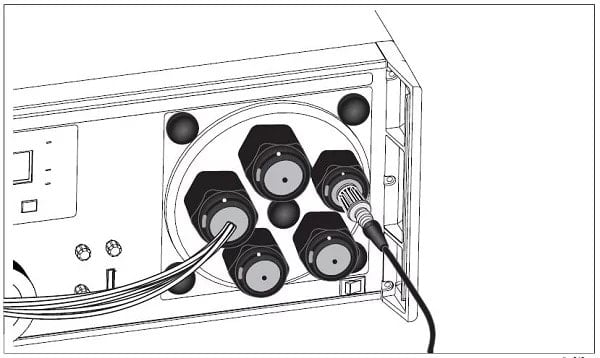
Calibrating a hygrometer or other humidity sensor using a chilled mirror sensor head inserted into the humidity generator's chamber
- Remote head. In this method the chilled mirror sensor head is inserted into the humidity generator’s chamber. This method reduces the risk of condensation and an external pump is normally not required.
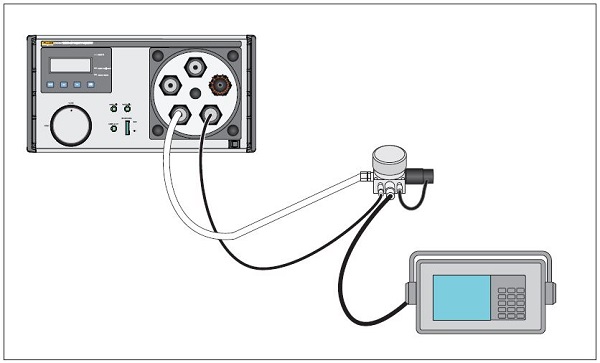 Calibrating a hygrometer or other humidity sensor using a humidity generator with remote head with pumped air
Calibrating a hygrometer or other humidity sensor using a humidity generator with remote head with pumped air
- Remote head with pumped air. Draw a gas sample from the humidity chamber to the chilled mirror remote head sensor by inserting a tube inside the generator. Note: when drawing gas out of the chamber, the dew point of the gas must be lower than ambient temperature; otherwise a heated tube must be used to prevent condensation from forming in the tube.
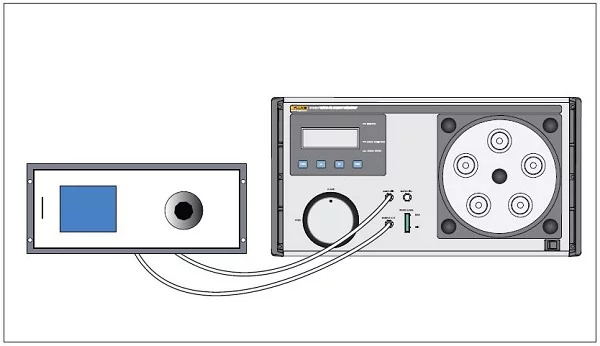
Humidity generator performing a calibration using a chilled-mirror sensor with pump style setup
- Pump style. Most chilled mirror hygrometer systems have a built-in chilled mirror sensor so air is pumped from the humidity generator (or calibrator) into the chilled mirror measurement system. In most cases the air is returned to the generator using a return line. Again, watch for condensation in the lines by keeping the dew point of the air lower than ambient temperature.
Tips to ensure a successful calibration and humidity measurement
- Separate the measurement area from ambient using a humidity calibrator that effectively isolates the DUT sensor from ambient effects like temperature and humidity.
- Don’t allow air leaks between the inside and outside of the calibrator’s chamber.
- Ensure that you insert your sensors properly so they are isolated from ambient temperature.
- Don’t allow condensation to form.
- Wait long enough for the humidity generator to become stable and uniform along with the DUT.
- Avoid using materials such as plastics, wood and foam that absorb and emit water vapor.
- Use materials like PTFE nonstick coating and stainless steel for making humidity measurements.
- Avoid exposing the DUT or calibrator to volatile chemicals. Materials like perfumes and cleaners can damage humidity sensors.
- Keep the calibrator’s humidity chamber clean.
- Use only distilled water in the calibrator.
- Keep the door on the calibrator’s humidity chamber at all times.
- Monitor the chamber temperature/humidity sensor for drift using an external check standard. A chilled mirror hygrometer is often used for this purpose.
Learn more
If you’d like more information about humidity and humidity calibration, I’ve recorded a webinar called “How to Calibrate Humidity Sensors.” You can download and watch it any time.
Related products
5128A RHapid Cal Humidity Generator / Calibrator
1620A Digital Thermometer-Hygrometer
Get help
Customer & technical support
Speak with a calibration product expert about your equipment needs
Common humidity terms: helpful definitions
Humidity: the presence of water in a gas, most commonly the gas is air. Humidity amount can be measured and expressed using several different methods and measurement quantities.
Relative humidity (%rh): is the most common way to indicate how much water vapor is in a gas. It is expressed as the percent of water vapor saturation at the accompanying temperature. At any given temperature air can only hold a certain amount of vapor before saturation is reached and the vapor turns into condensation. So %rh is the percent of actual water vapor in ratio with the amount that would cause saturation.
Hygrometer: an instrument that indicates humidity. If the instrument measures humidity and air temperature, it is a thermo-hygrometer.
Psychrometer: an instrument that measures humidity using two thermometers. One thermometer is placed in a water-soaked sock so evaporation will cool the thermometer. A chart is used to convert the difference in temperature between the regular thermometer and the water-soaked thermometer as the temperature difference is rated to the evaporation rate which is related to humidity.
Dew point: the temperature at which a gas (usually air) is cooled to the point that 100% water vapor saturation is achieved so the vapor condenses. Dew point is often used in weather forecasting to describe humidity of air. Frost point is used when the condensation forms as ice. If you could attach a thermometer to your bathroom mirror, you could measure the precise temperature at which moist air from the shower condenses (fogs) onto the mirror. This temperature is the dew point in the bathroom. If you also measured the air temperature in the bathroom, you could combine that with dew point to calculate relative humidity.
{
"@context": "https://schema.org",
"@type": "BlogPosting",
"mainEntityOfPage":{
"@type":"WebPage",
"@id":"https://us.flukecal.com/blog/how-accurately-calibrate-hygrometer"
},
"headline": "How to Accurately Calibrate a Hygrometer",
"image": {
"@type": "ImageObject",
"url": "https://us.flukecal.com/sites/flukecal.com/files/calibrating-humidity-sensors-with-mixed-flow-humidity-generator-calibrator.jpg",
"height": 600,
"width": 399
},
"datePublished": "2019-12-04",
"dateModified": "2019-12-11",
"author": {
"@type": "Person",
"name": "Michael Coleman"
},
"publisher": {
"@type": "Organization",
"name": "Fluke Calibration",
"logo": {
"@type": "ImageObject",
"url": "https://us.flukecal.com/sites/flukecal.com/files/fluke-calibration-logo-min.jpg",
"width": 1268,
"height": 526
}
},
"description": "Get step-by-step instructions on how to accurately calibrate a hygrometer or other humidity sensor including why it’s important, techniques, and tips."
}
- Início
- Produtos
- Novos Produtos
- Calibração elétrica
- Calibração de RF
- Equipamento de aquisição de dados e de teste
- Calibração de temperatura
- Calibração de umidade
- Calibração de pressão
- Medidores de pistão
- Controlador/Calibradores
- Monitores de pressão
- Balanças de peso morto
- Calibradores manuais e monitores
- Handheld Pressure Calibrators
- Calibração de dados de aéreos
- Monitores ambientais
- Acessórios de calibração de pressão
- Sistemas personalizados de calibração de pressão
- Software de calibração de pressão
- Calibração de fluxo
- Ferramentas de Calibração de processo
- Software de calibração
- Serviço e suporte
- Todos os instrumentos de calibração
- Onde Comprar
- Notícias
- Treinamento e eventos
- Literatura e educação
- Serviço e Suporte
- Service Request (RMA)
- Planos de Serviço
- Suporte técnico
- Base de Conhecimento
- Acreditações
- Centros de assistência autorizados
- Calibration Certificates
- Community Forum
- My MET/SUPPORT
- Manuais de produto (Guias de usuário)
- Folhas de Dados de Segurança (SDS)
- Safety, Service, and Product Notices
- Downloads de software
- Sobre Nós


